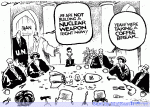By Golnar Motevalli, Bloomberg Businessweek

Ahmad, who runs an advertising agency in a busy commercial district of Tehran, has given up trying to get a business loan from any of the dozens of lenders just a short walk from his office.
Money is harder to come by in a struggling economy, and Ahmad’s experience reflects the financial problems in a country that three years ago looked to be on the cusp of prosperity after a rapprochement with the U.S. and Europe. Now it’s flirting with its own version of the credit crunch that crippled Western banks a decade ago. With the deal on its nuclear program failing to deliver promised gains, experts in Tehran say a banking crisis poses a bigger economic threat to the country than any decision by Donald Trump to rip up the agreement.
The solutions aren’t clear. The industry is largely cut off from the outside world and relies on the Central Bank of Iran to pump money into the system. Parviz Aghili-Kermani, board member and managing director of privately owned Middle East Bank Co., told an audience of investors and executives in Switzerland in October that it could cost the country as much as $200 billion to overhaul the banking system, roughly equal to about half the economy. Iran can’t afford that, he said.
A fix would also require several banks to merge with healthier ones, or, he suggested, to be done away with altogether. Bankers in Iran worry that healthy institutions would be destroyed by taking on a big bank with toxic assets. Should the worst of them be allowed to fail, there could be civil unrest. “Iranians haven’t been through a banking crisis before, and they don’t know how it plays out,” says Charles Robertson, global chief economist at Renaissance Capital in London. “Once you’ve been through a banking crisis, you then spend the next 20 years worrying about a banking crisis.”
Many of the country’s 35 licensed financial institutions are trying to repair their books after offering deposit rates of as high as 22 percent in 2014 to lure money when oil prices were high. (Although they carry rates, loans and deposits are structured to comply with the Islamic ban on interest.) The assets underpinning the loans, such as office blocks and shopping malls, have dropped in value in subsequent years. The central bank’s latest figures, published in January, put bad loans at $26.6 billion. That’s about 11 percent of total lending, down from 15 percent when President Hassan Rouhani came to power in 2013 and sought to open up the economy.
Yet the problem could be bigger than it looks. The central bank is limited in its ability to pursue a chunk of the unpaid debt because it’s owed by state institutions and powerful companies and individuals connected to them, one Western senior diplomat says. Saderat Bank, which says it runs Iran’s largest banking network, had a loss equal to about $1.5 billion for the nine months ended in December, according to a financial statement it posted on the Tehran Stock Exchange’s website.
Banks took deposits and “invested the money in high-risk projects, particularly in the property sector,” Rahmani says. “Look across the city,” he says, gesturing toward the skyline, where office blocks yet to be completed loom like giant cages of iron girders. “Most of the projects you see that are unfinished are a result of this problem.”
Questions sent to central bank officials by Bloomberg in February weren’t answered. Requests for interviews with managers at Middle East Bank, Eghtesad Novin Bank, Saman Bank, Bank Saderat, Bank Melli Iran, and Ayandeh Bank were either declined or not answered. “We are a strong bank,” says Mohammad Reza Mansouri, general manager in Frankfurt for Sepah Bank, Iran’s oldest state-run bank.
The country has already seen a dress rehearsal of sorts with the collapse of several so-called credit institutions. These are unregulated and, in many cases, unlicensed lenders that aren’t banks, some of which offered rates of as much as 85 percent to select individuals. Their collapse helped fuel protests in January, and the government has spent billions of dollars trying to recover customer deposits and consolidate the industry.
Inflation is running at 9.6 percent, partly as a result of the central bank injecting money into the system, and unemployment is high. Concerns about Iran slipping back into a period of isolation roiled its markets this month, with the rial plummeting as demand for dollars soared. Rouhani has complained specifically about banks. He called on them to end “nonbanking” practices such as owning businesses. “Why is it that in every street we have to see so many branches for each bank? Where did they get all this money to be able to pay for the expensive buildings?” he asked central bank officials on March 4, according to the partly state-funded Iranian Students’ News Agency.
The effect is that the economy is short of credit just when businesses need it most. Ahmad, who runs the ad agency, ended up getting a personal loan using his home as collateral. “The banking system is something that could really help us as a business to progress,” he says. “But there are a thousand and one barriers in front of us.”
Read original article at: https://www.bloomberg.com/news/articles/2018-04-19/iran-s-biggest-threat-has-nothing-to-do-with-trump










